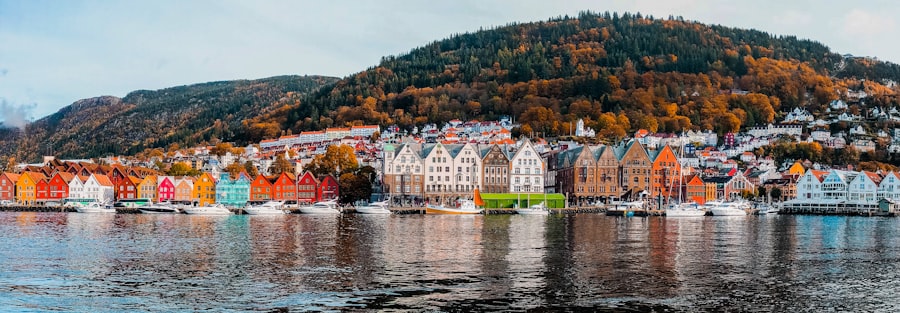Syttende Mai, or Constitution Day, is a day of immense importance in Norway, celebrated annually on the 17th of May. This day marks the signing of the Norwegian Constitution in 1814, a pivotal moment that laid the foundation for Norway’s independence and democratic governance. The significance of Syttende Mai extends beyond mere historical remembrance; it embodies the spirit of national pride, unity, and cultural heritage.
On this day, Norwegians from all walks of life come together to celebrate their identity, showcasing their love for their country through various festivities. The celebrations are characterised by parades, music, and traditional foods, creating an atmosphere of joy and camaraderie. Children play a central role in the festivities, often participating in parades while waving flags and singing songs.
The day serves as a reminder of Norway’s journey towards freedom and democracy, fostering a sense of belonging among its citizens. As such, Syttende Mai is not just a public holiday; it is a heartfelt celebration of Norwegian values and traditions that resonate deeply within the hearts of the people. Your journey to a smooth relocation starts here. Talk one-on-one with a Norway Relocation specialist and turn your plan into a reality.
Summary
- Syttende Mai is the Norwegian Constitution Day and holds great significance in Norwegian culture and history.
- Wearing bunad on Syttende Mai is a cherished tradition that symbolizes national pride and connection to Norwegian heritage.
- There are various styles of bunad, each representing different regions of Norway and featuring unique designs and embroidery.
- When choosing a bunad for Syttende Mai, consider factors such as your family’s heritage, personal style, and the formality of the event.
- Dress codes for Syttende Mai celebrations often include wearing bunad or formal attire to show respect for the occasion and Norwegian culture.
The tradition of wearing bunad on Syttende Mai
One of the most cherished traditions associated with Syttende Mai is the wearing of the bunad, a traditional Norwegian costume that reflects the rich cultural heritage of the country. The bunad is more than just clothing; it is a symbol of national pride and identity. Each region in Norway boasts its own unique style of bunad, often adorned with intricate embroidery and vibrant colours that tell stories of local history and customs.
Wearing a bunad on Syttende Mai is a way for individuals to connect with their roots and honour their ancestors. The tradition of donning a bunad on this special day has evolved over the years, but its essence remains unchanged. It is common to see families dressed in matching bunads, showcasing their regional affiliations and celebrating their shared heritage.
The act of wearing a bunad is not merely about aesthetics; it is a profound expression of love for one’s country and an appreciation for the traditions that have been passed down through generations. As such, Syttende Mai becomes a vibrant tapestry of colours and patterns, each bunad telling its own story while contributing to the collective narrative of Norwegian culture.
Exploring the different styles of bunad

The diversity of bunad styles across Norway is truly remarkable, with each region offering its own distinct designs and characteristics. From the elegant simplicity of the Telemark bunad to the elaborate embellishments of the Hardanger bunad, there is a wealth of options to choose from. Each style is steeped in history, often reflecting the local customs, climate, and available materials.
For instance, the Nordland bunad features bright colours and intricate silver jewellery, while the Setesdal bunad is known for its striking black and red colour scheme. Moreover, the variations in bunad styles extend beyond aesthetics; they also encompass different cultural practices associated with each region. Some bunads are traditionally worn during specific celebrations or rites of passage, while others are more versatile and can be worn for various occasions.
This rich tapestry of styles allows individuals to express their personal connection to their heritage while also celebrating the broader Norwegian culture. As one explores the different styles of bunad, it becomes evident that each piece is not just clothing but a living testament to Norway’s diverse history.
How to choose the right bunad for Syttende Mai
Choosing the right bunad for Syttende Mai can be both an exciting and daunting task, given the plethora of options available. The first step in this process is to consider your regional affiliation or family heritage. Many individuals opt for a bunad that represents their family’s roots, allowing them to honour their ancestry while participating in the celebrations.
If you are unsure about which style resonates with you, seeking guidance from family members or local experts can provide valuable insights. Another important factor to consider is comfort. Since Syttende Mai celebrations often involve parades and social gatherings, it is essential to select a bunad that allows for ease of movement.
Pay attention to the fit and fabric; some styles may be more suitable for warmer weather, while others may provide added warmth during cooler spring days. Additionally, consider your personal style preferences—whether you gravitate towards bold colours or subtle patterns—ensuring that your chosen bunad reflects your individuality while still honouring tradition.
Dress codes for Syttende Mai celebrations
Syttende Mai celebrations are marked by a sense of festivity and joy, and as such, there are certain dress codes that attendees typically adhere to. While wearing a bunad is highly encouraged and often expected during these celebrations, there are also guidelines regarding how to wear it appropriately. For instance, it is customary to wear the bunad with pride, ensuring that it is clean and well-maintained.
Accessories should complement rather than overshadow the outfit, allowing the beauty of the bunad to shine through. In addition to bunads, many people opt for smart-casual attire that reflects the celebratory nature of the day. This can include traditional Norwegian clothing or modern outfits in patriotic colours—red, white, and blue—symbolising national pride.
Regardless of what you choose to wear, it is essential to approach Syttende Mai with respect for its cultural significance. Dressing appropriately not only enhances your experience but also contributes to the overall atmosphere of unity and celebration that defines this special day.
Accessories to complement your bunad

Accessories play a crucial role in completing the look when wearing a bunad on Syttende Mai. Traditional jewellery, such as silver brooches or necklaces, can add an elegant touch while also reflecting regional styles. Many bunads come with specific accessories that are integral to their design; for example, some may feature intricate silver belts or embroidered shawls that enhance their overall aesthetic.
When selecting accessories, it is important to consider how they harmonise with your chosen bunad without overwhelming it. In addition to jewellery, other accessories such as hats or hairpieces can further elevate your look. Many women choose to adorn their hair with floral crowns or decorative pins that echo the colours and patterns of their bunads.
For men, traditional hats or caps can add a touch of authenticity to their attire. Ultimately, accessories should serve as an extension of your personal style while honouring the traditions associated with Syttende Mai.
Tips for styling your bunad for Syttende Mai
Styling your bunad for Syttende Mai involves more than just putting on a beautiful outfit; it requires attention to detail and an understanding of how to present yourself with grace and confidence. One key tip is to ensure that your bunad fits well; if necessary, consider having it tailored to achieve the perfect fit. A well-fitted bunad not only looks better but also allows you to move comfortably throughout the day’s festivities.
Another important aspect of styling your bunad is considering your hair and makeup. Many individuals choose to keep their hairstyles simple yet elegant, often opting for braids or updos adorned with flowers or decorative pins. Makeup should be kept natural and understated, allowing your bunad to take centre stage.
Finally, remember to wear comfortable shoes; while traditional footwear may be preferred by some, practicality should not be overlooked when participating in parades or social gatherings.
Alternatives to bunad for Syttende Mai
While wearing a bunad is a cherished tradition on Syttende Mai, there are alternatives for those who may not have access to one or prefer different styles of attire. Many people opt for smart-casual outfits that incorporate elements of Norwegian culture without being overly formal. This could include wearing clothing in national colours or incorporating traditional patterns into modern garments.
Additionally, some individuals choose to wear folk costumes from other cultures as a way to celebrate diversity within Norway’s multicultural society. This approach fosters inclusivity while still honouring the spirit of Syttende Mai. Ultimately, whether you choose to wear a bunad or an alternative outfit, what matters most is participating in the celebrations with joy and respect for Norwegian culture.
Dressing for different Syttende Mai events
Syttende Mai celebrations can vary widely in terms of formality depending on the specific events taking place throughout the day. For instance, parades are typically more casual and festive environments where wearing a bunad or smart-casual attire is appropriate. In contrast, formal gatherings such as receptions or dinners may call for more elegant attire that adheres closely to traditional dress codes.
When planning your outfit for different events on Syttende Mai, consider both comfort and appropriateness based on the occasion’s nature. If attending multiple events throughout the day, layering can be an effective strategy; this allows you to adapt your look as needed while maintaining a cohesive style throughout your celebrations.
Etiquette for wearing bunad on Syttende Mai
Wearing a bunad on Syttende Mai comes with certain etiquette that reflects respect for tradition and cultural significance. First and foremost, it is essential to treat your bunad with care; this includes ensuring it is clean and well-maintained before wearing it on this special day. Additionally, when interacting with others who are also wearing bunads, it is customary to compliment their attire as a gesture of appreciation for shared cultural heritage.
Furthermore, understanding how to behave while wearing a bunad is equally important. This includes being mindful during parades or public gatherings—maintaining decorum while still enjoying the festivities contributes positively to the overall atmosphere of celebration. By adhering to these etiquette guidelines, individuals can honour both their own heritage and that of others while participating in Syttende Mai celebrations.
Honouring Norwegian culture through your attire on Syttende Mai
Ultimately, dressing for Syttende Mai is about more than just clothing; it is an opportunity to honour Norwegian culture and heritage through personal expression. Whether you choose to wear a traditional bunad or opt for alternative attire that reflects national pride, what matters most is embracing the spirit of celebration that defines this special day. By thoughtfully selecting your outfit and accessories while adhering to cultural etiquette, you contribute positively to the collective experience of joy and unity that characterises Syttende Mai.
As you prepare for this significant occasion, consider how your attire can serve as a bridge between past and present—connecting you with generations before you while also allowing you to express your individuality within Norway’s rich cultural tapestry. In doing so, you not only celebrate your own identity but also contribute to preserving and promoting Norwegian traditions for future generations to cherish. In conclusion, as you embark on your journey towards celebrating Syttende Mai with pride and joy, remember that every detail counts—from choosing the right bunad or alternative attire to accessorising thoughtfully and adhering to etiquette guidelines.
Embrace this opportunity not only as a chance to celebrate Norway’s history but also as an occasion to connect with fellow Norwegians in shared appreciation for culture and community.
Register for a Norwegian class at the NLS Norwegian Language School now!

